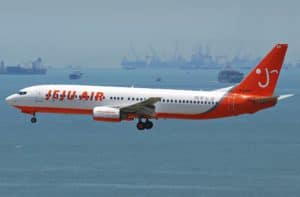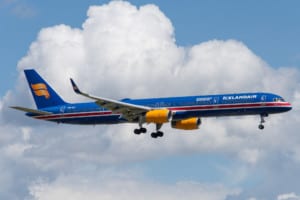When it comes to airplanes, there are two types of people in the world: those who know the difference between a 737 and a 757 and those who don’t. The first group is smug about their knowledge, while the second group is baffled by all the technical talk they hear at airports. But no matter which group you belong to, there’s something you need to know about these two planes.
| Aircraft: | Boeing 737-800 | Boeing 757-300 |
|---|---|---|
| Photo: |
 |
 |
| Country: | United States | United States |
| Manufactured: | from: 1998 to: Present | from: 1998 to: 2004 |
| ICAO: | B738 | B753 |
| Price: | $89.2 million | $80 million |
| Avionics: | Rockwell Collins avionics | Rockwell Collins Avionics |
| Engine: | 2x Snecma / CFM56-7B27 | 2x Rolls-Royce RB211-535E4/B, Pratt & Whitney PW2000-40/43 |
| Engine Type: | Turbofan | Turbofan |
| Power: | 27,300 pound-force | 43,500 pound-force |
| Max Cruise Speed: |
473 knots 876 Km/h |
496 knots 919 Km/h |
| Approach Speed (Vref): | - | 140 knots |
| Travel Range: |
3,060 Nautical Miles
5,667 Kilometers |
3,467 Nautical Miles
6,421 Kilometers |
| Fuel Economy: |
0.44 nautical mile / gallon 0.215 kilometres / litre |
0.3 nautical mile / gallon 0.147 kilometres / litre |
| Service Ceiling: | 41,000 feet | 42,000 feet |
| Rate of Climb: | - |
3500 feet / minute 17.78metre / second |
| Take Off Distance: |
2316 metre 7,598.33 feet |
2600 metre 8,530.08 feet |
| Landing Distance: |
1372 metre 4,501.26 feet |
1550 metre 5,085.24 feet |
| Max Take Off Weight: |
384,039 Kg 846,652 lbs |
123,830 Kg 272,996 lbs |
| Max Landing Weight: | - |
101,610 Kg 224,009 lbs |
| Max Payload: |
21,319 Kg 47,000 lbs |
30,940 Kg 68,210 lbs |
| Fuel Tank Capacity: |
6,875 gallon 26,025 litre |
11,490 gallon 43,494 litre |
| Baggage Volume: |
45.1 m3 1,593 ft3 |
67.5 m3 2,384 ft3 |
| Seats - Economy: | 189 seats | 295 seats |
| Seats - Business Class: | 175 seats | 243 seats |
| Seats - First Class: | 162 seats | - |
| Cabin Height: |
2.2 metre 7.22 feet |
2.13 metre 6.99 feet |
| Cabin Width: |
3.54 metre 11.61 feet |
3.54 metre 11.61 feet |
| Cabin Length: |
29.97 metre 98.33 feet |
43.21 metre 141.76 feet |
| Exterior Length: |
39.5 metre 129.59 feet |
54.43 metre 178.57 feet |
| Tail Height: | - | 13.64 metre - 44.75 feet |
| Fuselage Diameter: |
3.76 metre 12.34 feet |
3.76 metre 12.34 feet |
| Wing Span / Rotor Diameter: |
34.31 metre 112.56 feet |
38.06 metre 124.87 feet |
| Wing Tips: | No Winglets | Blended Tips |
| More Info: | Boeing 737-800 | Boeing 757-300 |
|
Data presented is for entertainment purposes and should not be used operationally.
|
Other Boeing 737-800 comparisons:
- Boeing 737-800 vs 777-200ER
- Boeing 747-8 vs 737-800
- Boeing 787-8 vs 737-800
- Airbus A380-800 vs Boeing 737-800
Other Boeing 757-300 comparisons:
About the Boeing 737
The Boeing 737 is a twin-jet airliner that can take short to medium-range flights, having first flown in 1967 and is still being produced today. It has been developed into several models, including the Classic, Next Generation, and MAX. Over 11,000 have been built, making it one of the most successful jet airliners ever.
The 737 is primarily used by airlines for domestic and short-haul international flights. Major operators include Southwest Airlines, Ryanair, United Airlines, and American Airlines. The 737 entered service with Lufthansa in 1968 and has since become one of the most widely used aircraft worldwide.
It remains a popular airline choice due to its low operating costs, reliability, and flexibility.
Why was it developed and built?
The 737 was developed and built by Boeing to replace the aging fleet of 707s, 720s, and 727s. It was designed to be an efficient yet affordable aircraft that could provide airlines with a cost-effective solution for short-haul routes. The 737 has since become the best-selling commercial aircraft in history, and its impressive performance has made it the standard for short-haul travel.
What purpose does it serve?
The Boeing 737 is designed for short-haul flights and can be used for various purposes. It is used to transport passengers from one place to another and is also commonly used for cargo transport. The aircraft is highly reliable and efficient, making it one of the most popular airline choices.
About the Boeing 757
The Boeing 757 is a twin-engine jetliner that was first introduced in 1983. It can reach speeds of up to 982 km/h and has a range of 7,222 km. The 757 is 47 m long and has a wingspan of 38 m. It typically carries between 201 and 289 passengers, depending on the configuration.
The 757 is powered by either Rolls-Royce RB211 or Pratt & Whitney PW2000 engines. It has a takeoff speed of around 290 km/h. The unit cost of the 757 is between 80 and 100 million USD (2013). Despite being introduced over 30 years ago, the 757 remains a popular airline choice due to its reliability and efficiency.
Why was it developed and built?
The idea to stretch the 727 was first proposed in the early 1990s. Boeing and several operating airlines wanted a successor to the famous jet aircraft. They felt that the extended version would provide greater capacity and better performance.
The prototype was built in 1992 and first flew in 1993. After several years of testing, the aircraft was certified in 1998 and began commercial service the following year. Since then, it has become one of the most popular jet aircraft.
What purpose did it serve?
The 757 was designed to be a cost-effective solution for short-haul and medium-range flights. It is capable of carrying up to 289 passengers and is well-suited for both domestic and international flights. The 757 is also famous for cargo transport due to its wide fuselage and high payload capacity. The aircraft is also highly reliable and efficient, making it an attractive airline.
How are Boeing 737 and Boeing 757 different?
The Boeing 737 and 757 are two very different airplanes. The 737 is a short-to-medium-range narrowbody airliner, while the 757 is a long-range widebody airliner. The 737 is powered by two wing-mounted CFM56 turbofan engines, while two Rolls-Royce RB211 turbofan engines power the 757.
The 737 has a maximum takeoff weight of 80,000 lb (36,287 kg), while the 757 has a maximum takeoff weight of 255,000 lb (116,000 kg). The 737 range is 2,950 miles (4,750 km), while the 757 range is 5,310 miles (8,560 km).
The 737 can carry up to 149 passengers, while the 757 can carry up to 239 passengers.
How are Boeing 737 and Boeing 757 similar?
Boeing 737 and Boeing 757 are two very popular commercial airplanes. Both are narrow-body jets that can seat between 130 and 210 passengers and are used extensively by major airlines worldwide. But what else do these two planes have in common?
For one thing, they share a similar design philosophy. The 737 and the 757 were designed to be “fly-by-wire” aircraft, meaning that computer systems would digitally control many of the plane’s flight surfaces rather than using cables and hydraulics as in older planes. This helped to make the aircraft lighter and more fuel efficient.
In addition, both planes use high-bypass turbofan engines, which are quieter and more fuel efficient than older engine types.
Finally, both planes were designed with “commonality” in mind, meaning many of their parts are interchangeable. This helps keep maintenance and training costs down for airlines that operate both aircraft types.
What’s better about Boeing 737?
Engine:
The 737 MAX comes with the latest CFM LEAP-1B engine, which offers improved fuel efficiency and higher thrust for takeoff.
Safety:
The 737 MAX is one of the safest aircraft in its class and has been designed with a focus on safety. It includes an advanced flight deck, improved systems redundancies, auto-deployment of flight spoilers for better control during takeoff and landing, and dual-channel angle-of-attack (AOA) sensors that provide improved protection against upsets and stalls.
Economy:
The 737 MAX ranges to 6,430 nautical miles (7,556 km), making it ideal for long-haul flights without needing additional fuel stops.
It also offers lower operating costs per seat than other commercial aircraft. This makes it an attractive choice for budget-conscious airlines.
What’s better about Boeing 757?
Design:
The 757 is a wide-body, dual-aisle aircraft that offers more excellent interior space and seating capacity than the 737. It also has a more extended range and can accommodate up to 261 passengers in two classes of service. This makes it ideal for medium to long-haul flights that require more space and cargo capacity.
Engine:
The 757 is powered by two high-bypass turbofan engines and can reach speeds of up to 540 mph (870 km/h). This makes it one of the fastest aircraft in its class. Additionally, its engines are designed to be fuel-efficient and reduce engine noise, making it an eco-friendly option for airlines.
Conclusion
The Boeing 737 and 757 are two very different airplanes. The 737 is a short-to-medium-range narrow body airliner, while the 757 is a long-range wide body airliner. Both planes share similar design philosophies and commonality of parts to help make maintenance and training costs more cost-effective for airlines.


